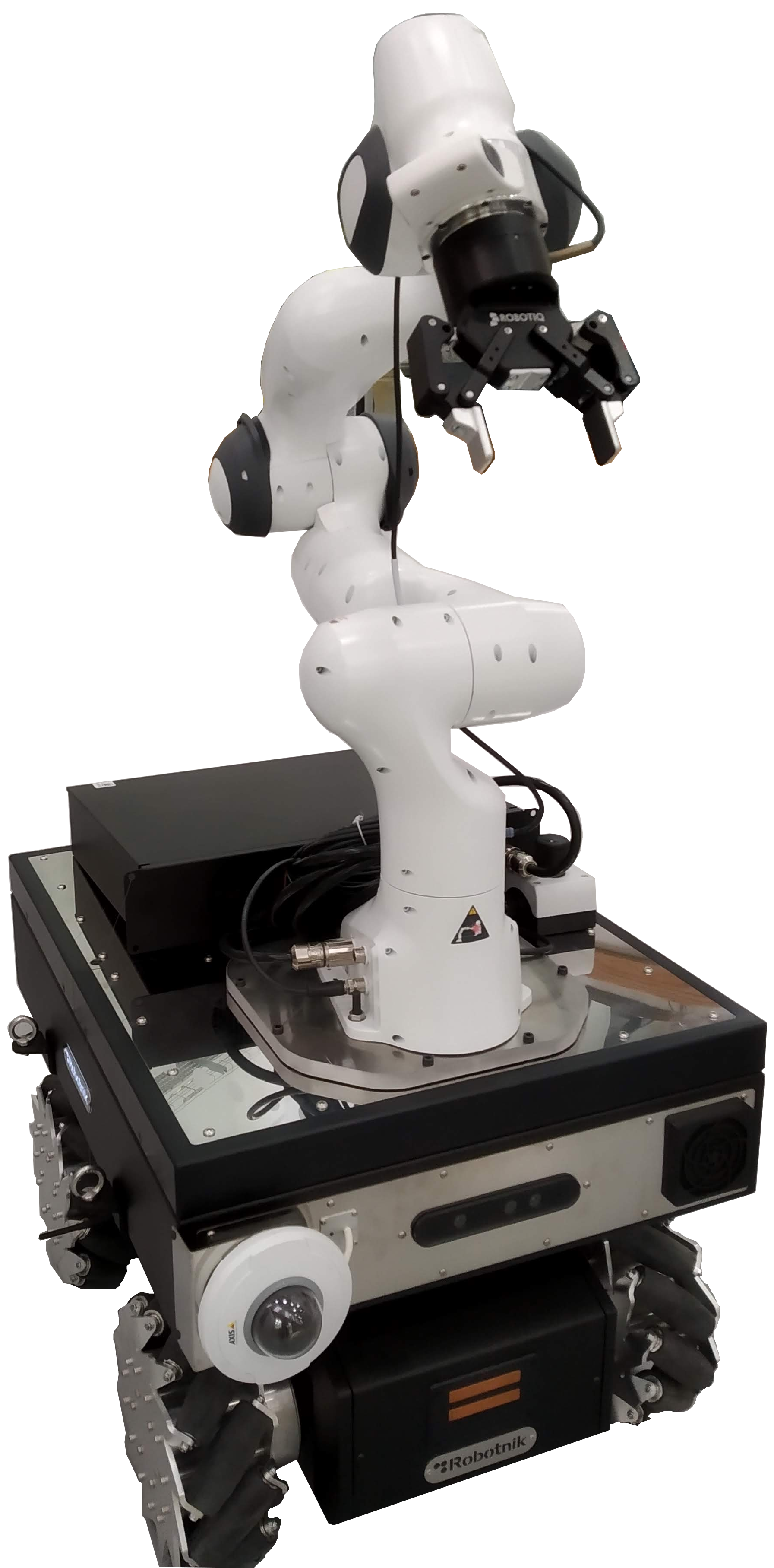Robot Perception and Learning Lab

Robots
1x G1 Humanoid Robot (Unitree Robotics)
 Robot description: G1 is Unitree Robotics' advanced humanoid robot,
designed for dynamic locomotion, manipulation, and human-like interaction. G1 supports a wide range of research activities,
including whole-body motion planning, vision-based control, and real-time decision making. Its compact yet powerful design
enables robust performance in both structured and semi-structured environments, making it ideal for exploring human-robot collaboration,
agile navigation, and dexterous tasks.
Robot Specs: Control: high-level and low-level; Height: 1.27m; Weight: 47kg;
DoF: 23 (body), 34 (with dexterous hands); Max Speed: 2m/s; Battery: 2h+ operation.
Robot description: G1 is Unitree Robotics' advanced humanoid robot,
designed for dynamic locomotion, manipulation, and human-like interaction. G1 supports a wide range of research activities,
including whole-body motion planning, vision-based control, and real-time decision making. Its compact yet powerful design
enables robust performance in both structured and semi-structured environments, making it ideal for exploring human-robot collaboration,
agile navigation, and dexterous tasks.
Robot Specs: Control: high-level and low-level; Height: 1.27m; Weight: 47kg;
DoF: 23 (body), 34 (with dexterous hands); Max Speed: 2m/s; Battery: 2h+ operation.
1x Spot Robot (Boston Dynamics)
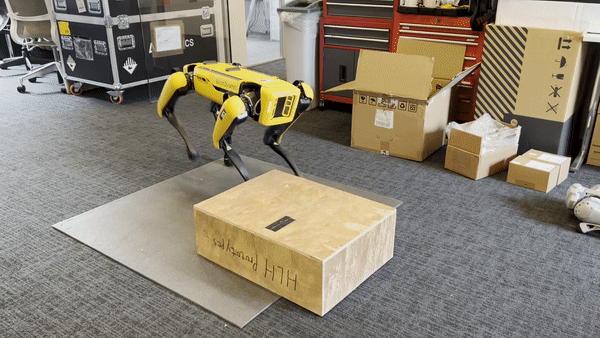 Robot description: Spot Boston Dynamics' flagship quadrupedal robot,
designed to navigate and inspect challenging terrains. The robust platform supports a variety of research applications,
particularly focusing on high-level path planning and perception systems. Spot is engineered to assist in real-world environments where
traditional wheeled or tracked robots face limitations, offering capabilities in inspection, data collection, and mobility on uneven surfaces.
Robot Specs: Control: high-level; Lenght: 1.1m;
Width: 0.5m; Height: 0.61m; Weight: 32.7kg; DoF: 12; Max Speed: 1.6m/s; Battery: 90-180min.
Robot description: Spot Boston Dynamics' flagship quadrupedal robot,
designed to navigate and inspect challenging terrains. The robust platform supports a variety of research applications,
particularly focusing on high-level path planning and perception systems. Spot is engineered to assist in real-world environments where
traditional wheeled or tracked robots face limitations, offering capabilities in inspection, data collection, and mobility on uneven surfaces.
Robot Specs: Control: high-level; Lenght: 1.1m;
Width: 0.5m; Height: 0.61m; Weight: 32.7kg; DoF: 12; Max Speed: 1.6m/s; Battery: 90-180min.
1x ANYmal-C Robot (ANYbotics)
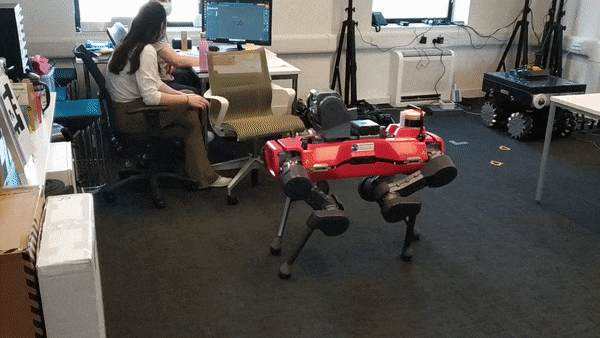 Robot description: ANYmal, developed by ANYbotics, is a highly versatile
quadrupedal robot designed specifically for navigating and inspecting challenging and complex terrains. Its robust design makes it ideal for
inspection tasks in environments where traditional wheeled or tracked robots are unsuitable. To enhance its inspection capabilities, the ANYmal
is equipped with an advanced Inspection Payload, featuring a pan-tilt unit with a high-resolution optical zoom camera, thermal imaging capabilities,
a LED spotlight for low-light conditions, and a directional microphone for audio capture. These tools enable precise and thorough data collection
in a wide range of settings, from industrial facilities to outdoor environments. The ANYmal platform supports low-level control, making it an ideal
research tool for advancing locomotion algorithms, environmental perception, and planning techniques. Researchers leverage ANYmal to explore novel
approaches to robotic movement and navigation across rough and dynamic surfaces, contributing to fields such as autonomous exploration, inspection,
and monitoring.
Robot Specs: Control: torque-control; Lenght: 0.8m; Width: 0.6m;
Height: 0.7cm; DoF: 12; Max Speed: 1m/s; Battery: 90min.
Robot description: ANYmal, developed by ANYbotics, is a highly versatile
quadrupedal robot designed specifically for navigating and inspecting challenging and complex terrains. Its robust design makes it ideal for
inspection tasks in environments where traditional wheeled or tracked robots are unsuitable. To enhance its inspection capabilities, the ANYmal
is equipped with an advanced Inspection Payload, featuring a pan-tilt unit with a high-resolution optical zoom camera, thermal imaging capabilities,
a LED spotlight for low-light conditions, and a directional microphone for audio capture. These tools enable precise and thorough data collection
in a wide range of settings, from industrial facilities to outdoor environments. The ANYmal platform supports low-level control, making it an ideal
research tool for advancing locomotion algorithms, environmental perception, and planning techniques. Researchers leverage ANYmal to explore novel
approaches to robotic movement and navigation across rough and dynamic surfaces, contributing to fields such as autonomous exploration, inspection,
and monitoring.
Robot Specs: Control: torque-control; Lenght: 0.8m; Width: 0.6m;
Height: 0.7cm; DoF: 12; Max Speed: 1m/s; Battery: 90min.
2x B1/Z1 Robots (Unitree Robotics)
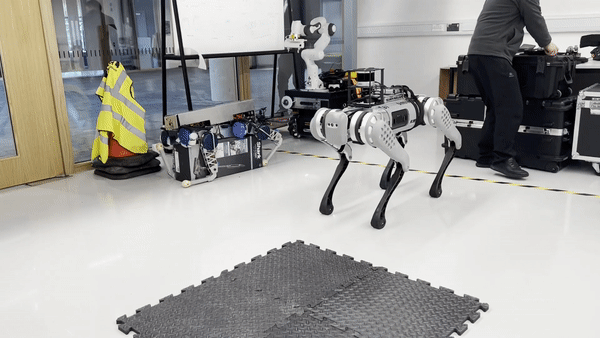 Robot description: B1 with Z1 is a large-scale quadrupedal robotic platform, equipped with a
fully torque-controlled robotic arm, making them highly agile and powerful. These advanced platforms are designed for research on complex loco-manipulation
tasks, where both movement and manipulation of objects are integrated into robotic actions. With support for low-level control, B1 and Z1 are particularly
well-suited for research on locomotion, manipulation, path planning, and environmental perception. These platforms provide a flexible foundation for
experimenting with advanced robot learning techniques, allowing researchers to explore cutting-edge solutions in robot interaction with dynamic environments.
Thanks to their strength and precision, B1 and Z1 are ideal for tasks requiring simultaneous navigation and manipulation, making them invaluable tools for
advancing the field of loco-manipulation and autonomous robotic systems.
B1 Robot Specs: Control: torque; Weight: 50kg; Maxc Payload: 40kg; Length: 1.11m; Height: 0.67m; Max Speed: 1.8m/s; Slopes: 35deg;
GPU: Jetson Xavier; 5G wireless network; GNSS; Battery: 2-4h.
Z1 Robot Specs:Weight: 4.3kg; Payload: 3kg; DoF: 6; Cotrol: position, force.
Robot description: B1 with Z1 is a large-scale quadrupedal robotic platform, equipped with a
fully torque-controlled robotic arm, making them highly agile and powerful. These advanced platforms are designed for research on complex loco-manipulation
tasks, where both movement and manipulation of objects are integrated into robotic actions. With support for low-level control, B1 and Z1 are particularly
well-suited for research on locomotion, manipulation, path planning, and environmental perception. These platforms provide a flexible foundation for
experimenting with advanced robot learning techniques, allowing researchers to explore cutting-edge solutions in robot interaction with dynamic environments.
Thanks to their strength and precision, B1 and Z1 are ideal for tasks requiring simultaneous navigation and manipulation, making them invaluable tools for
advancing the field of loco-manipulation and autonomous robotic systems.
B1 Robot Specs: Control: torque; Weight: 50kg; Maxc Payload: 40kg; Length: 1.11m; Height: 0.67m; Max Speed: 1.8m/s; Slopes: 35deg;
GPU: Jetson Xavier; 5G wireless network; GNSS; Battery: 2-4h.
Z1 Robot Specs:Weight: 4.3kg; Payload: 3kg; DoF: 6; Cotrol: position, force.
2x Go2-W, 2x Go2, 3x Go1, 1x A1 Robots (Unitree)
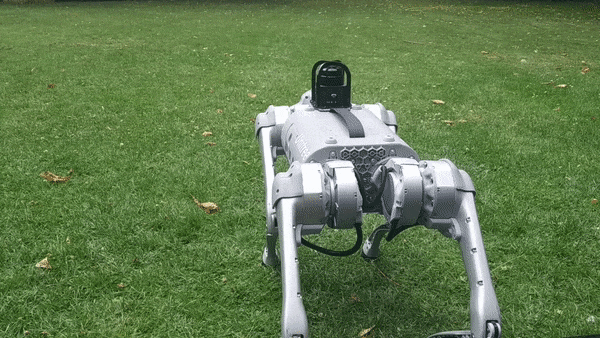 Robot description: Go1, Go2, and A1 are the latest small-scale quadrupedal platform developed by Unitree,
known for their agility, robustness, and versatility. Despite their compact size, they offers exceptional performance, making it an ideal platform for a
wide range of research in legged robotics, including control systems, path planning, and environmental perception. Due to their dynamic mobility and precise
control, they are extensively used in research on robot learning and simulation-to-reality (sim2real) experiments, allowing researchers to test algorithms
in simulated environments before deploying them in the real world. Its adaptability across diverse research domains makes it a powerful tool for advancing
legged robotic technologies and contributing to breakthroughs in autonomous systems.
Go1 Robot Specs: Control: torque; Weight: 12kg; Max Speed: 17km/h; Sensors: 5x fish-eye stereo depth cameras, 3 hypersonic sensors; Length:
0.59m; Height: 0.22m.
Robot description: Go1, Go2, and A1 are the latest small-scale quadrupedal platform developed by Unitree,
known for their agility, robustness, and versatility. Despite their compact size, they offers exceptional performance, making it an ideal platform for a
wide range of research in legged robotics, including control systems, path planning, and environmental perception. Due to their dynamic mobility and precise
control, they are extensively used in research on robot learning and simulation-to-reality (sim2real) experiments, allowing researchers to test algorithms
in simulated environments before deploying them in the real world. Its adaptability across diverse research domains makes it a powerful tool for advancing
legged robotic technologies and contributing to breakthroughs in autonomous systems.
Go1 Robot Specs: Control: torque; Weight: 12kg; Max Speed: 17km/h; Sensors: 5x fish-eye stereo depth cameras, 3 hypersonic sensors; Length:
0.59m; Height: 0.22m.
2x Jueying Lite2 Robot (Deep Robotics)
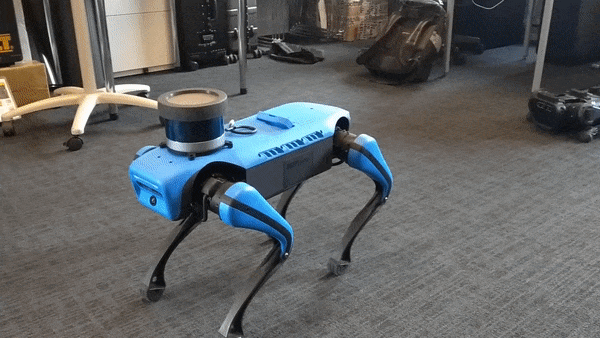 Robot description: Lite2 is a small-sized quadrupedal platform, developed by Deep Robotics,
known for its agility, robustness, and versatility. Designed for various research applications in legged robotics, the platform excels in areas such as control,
path planning, and perception, providing a solid foundation for exploring advanced robotic behaviors. The robot is particularly suited for robot learning and
simulation-to-reality (sim2real) experiments, making it a valuable tool in testing and refining algorithms in both virtual simulations and real-world environments.
Its adaptability and performance make it an essential asset for researchers aiming to push the boundaries of legged robot technologies and autonomous systems.
Robot description: Lite2 is a small-sized quadrupedal platform, developed by Deep Robotics,
known for its agility, robustness, and versatility. Designed for various research applications in legged robotics, the platform excels in areas such as control,
path planning, and perception, providing a solid foundation for exploring advanced robotic behaviors. The robot is particularly suited for robot learning and
simulation-to-reality (sim2real) experiments, making it a valuable tool in testing and refining algorithms in both virtual simulations and real-world environments.
Its adaptability and performance make it an essential asset for researchers aiming to push the boundaries of legged robot technologies and autonomous systems.
1x BRUCE Robot (Westwood Robotics)
 Robot description: BRUCE is a kid-sized humanoid robot designed to be a reliable, accessible,
and high-performance platform for researchers and educators worldwide. Its robust dynamic capabilities make it an ideal tool for advancing robotics research in
areas such as bipedal locomotion, control, and human-robot interaction. Developed as a joint project between RoMeLa and Westwood Robotics, BRUCE is an open-source
platform that fosters global collaboration by offering full accessibility to researchers and community members around the world. The BRUCE Open-Source Project
provides an excellent opportunity for researchers to contribute to and benefit from shared advancements in robotics technology. Through its open-platform design,
BRUCE aims to accelerate the development of innovative robotic solutions while supporting hands-on education for students and researchers alike. This collaborative
effort has the potential to significantly impact the future of robotics research and education on a global scale.
Robot description: BRUCE is a kid-sized humanoid robot designed to be a reliable, accessible,
and high-performance platform for researchers and educators worldwide. Its robust dynamic capabilities make it an ideal tool for advancing robotics research in
areas such as bipedal locomotion, control, and human-robot interaction. Developed as a joint project between RoMeLa and Westwood Robotics, BRUCE is an open-source
platform that fosters global collaboration by offering full accessibility to researchers and community members around the world. The BRUCE Open-Source Project
provides an excellent opportunity for researchers to contribute to and benefit from shared advancements in robotics technology. Through its open-platform design,
BRUCE aims to accelerate the development of innovative robotic solutions while supporting hands-on education for students and researchers alike. This collaborative
effort has the potential to significantly impact the future of robotics research and education on a global scale.
1x UCL Gripper (Luke Beddow)
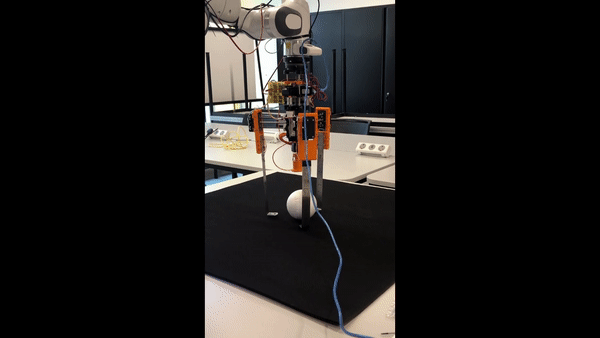 Robot description: The UCLGripper is developed by Luke Beddow during his PhD at University
College London (UCL), this innovative gripper design integrates caging-inspired manipulation techniques, utilizing flexible fingers and a movable palm to
enhance dexterity and versatility in robotic grasping. The gripper is designed to mimic the caging principle, where objects are constrained and secured by
the configuration of multiple fingers, without requiring precise finger-object contact points. This approach is particularly useful for handling objects of
varying shapes, sizes, and materials, which are often challenging for traditional rigid grippers.
Robot description: The UCLGripper is developed by Luke Beddow during his PhD at University
College London (UCL), this innovative gripper design integrates caging-inspired manipulation techniques, utilizing flexible fingers and a movable palm to
enhance dexterity and versatility in robotic grasping. The gripper is designed to mimic the caging principle, where objects are constrained and secured by
the configuration of multiple fingers, without requiring precise finger-object contact points. This approach is particularly useful for handling objects of
varying shapes, sizes, and materials, which are often challenging for traditional rigid grippers.
MPPL Robot
